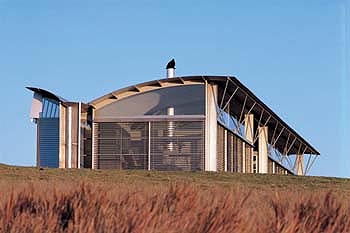Famous Australian architects
Index
Meet three of Australia’s most significant architects – Roy Grounds, Harry Seidler and Glenn Murcutt. These three famous Australian architects express a modernist aesthetic in their own individual ways.

While big-name structures usually steal the limelight, Australian architects have also produced some innovative residential projects that have changed the way we live. Roy Grounds, Harry Seidler and Glenn Murcutt are just three of the famous architects of Australia who have had a lasting impact on residential architecture, introducing modernist aesthetics and designing homes that work in harmony with the uniquely Australian landscape.
Grounds was a key figure in the modern movement. He was one of the main architects in Australia designing in the Melbourne regional style of architecture, which is characterised by narrow, linear forms with low-pitched gable roofs, exposed rafters, wide eaves and large areas of glass. One of Grounds’ key early works was Ranelagh (1934) in Mt Eliza, a three-storey beach house that blends wonderfully with its surroundings. He designed many residential buildings in the South Yarra-Toorak area of Melbourne, as well as in Canberra. His Moonbria blocks of flats (1941) in Mathoura Road, Toorak, is considered a key design, as are the Forrest Townhouses (1959) in Canberra, which are listed in the RAIA Register of Significant Twentieth Century Architecture.
Seidler was born in Austria, but in later life became an Australian citizen and one of the most celebrated architects in Australia. He was an exponent of a pure, modernist aesthetic, and is known for various residential structures in Sydney. His first design as an Australian architect was a house for his parents, the Rose Seidler House (1948), which was the first residential building in Australia to fully express Bauhaus principles. His 1961 block of apartments, the Blues Point Tower, caused (and continues to inspire) much negative attention due to its prominent position on Blues Point.
Similarly controversial is the Horizon block of apartments in Darlinghurst (1998), a prestressed concrete building with a ‘scalloped’ facade that has been criticised for its height and the fact that it supposedly overshadows surrounding buildings.
Glenn Murcutt is a highly influential Australian architect and is considered an exponent of both modernist and postmodernist architectural principles. He has designed a multitude of domestic buildings all over the country, particularly in bush and regional areas. Interestingly, he works as a sole practitioner, yet still exerts a globe-spanning influence. He is focused on low-tech, low-cost, sustainable design, with materials like timber, steel and glass often used in his work.
In 1992 Murcutt designed an extension to the famous Italianate mansion, Raheen, in Kew, Melbourne. This new residential wing is an impressive, transparent construction of steel and glass set on a stone base. In 2002 Murcutt won the coveted Pritzker Architecture Prize.
